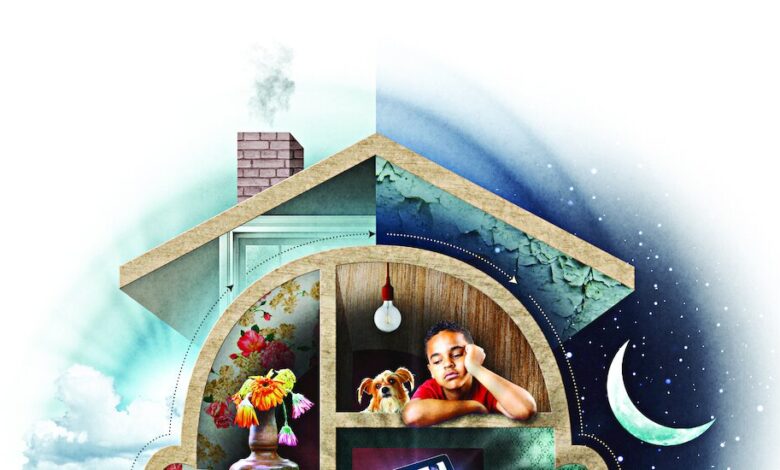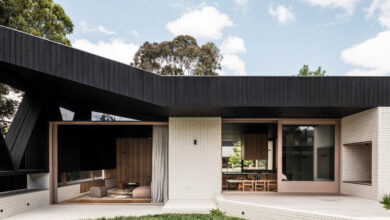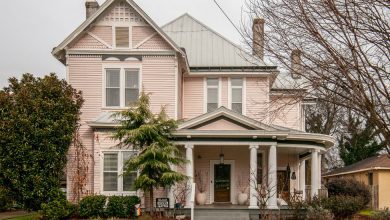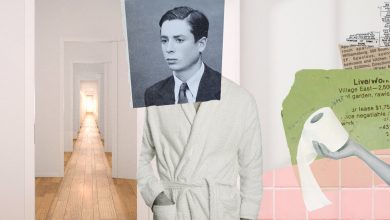What Does Home Mean to Us? Not the Same Thing It Did Before the Pandemic

[ad_1]
One spring more than 200 years ago, Xavier de Maistre, a well-to-do, well-read French army officer and balloon enthusiast, was sentenced to house arrest for a dueling incident. He spent 42 days in his bedroom, in a modest apartment on the top floor of a building in Turin, and wrote a whimsical travelogue of his time there called “A Journey Around My Room.”
Wearing his “traveling clothes” — a bathrobe and pajamas — he visited his comfy sofa, his desk, his cheerful pink-and-white bed (colors he recommended to his readers because they compelled him to wake up happy) and his memories, seeing all of these elements with fresh eyes. (He wrote a sequel, “Nocturnal Expedition Around My Room,” in which he journeyed by looking out his window at the night sky.) Like the Pevensie children, who stumbled into Narnia through an old wardrobe in a spare room, M. de Maistre found an entire world in a confined interior space, and pioneered, as Alain de Botton wrote in the forward to a reissue of both stories, a novel mode of experience: room travel.
During this long year of house arrest, our relationships to our homes, like M. de Maistre’s to his bedroom, have been altered in profound and ridiculous ways. Our homes have been a refuge and a prison, often filled with too many people (and their newly adopted shelter dogs) doing things the spaces were never meant for, like school, work and physical activity. (The 19th-century rural model — the home as the site of leisure and production — has been reprised, although the activity may be happening in a cramped apartment instead of an airy farmhouse.)
Partners and children have stayed put, which has been both a boon and a corrosive to family life, depending on the family — or the day. Or maybe the home has been empty save for one human, and the place that was intended to be a launching pad or a respite from the energy of public life may have felt like solitary confinement. And that’s if you’re lucky.
For the more than one million households that faced evictions last year, despite moratoriums in many states, the idea of home is evanescent, a relationship not just fraught, but unattainable, as even basic shelter becomes a luxury — and more completely out of reach.
After so many months confined to our homes, we asked those who think about place — architects, urban policy experts, novelists — how our relationships with our homes have changed, and what home means to them. (Their responses have been edited for clarity and condensed.)
We’re Tired of Our Homes — and They’re Tired of Us
Hashim Sarkis is the dean of the school of architecture and planning at the Massachusetts Institute of Technology and the curator of the 17th Venice Architecture Biennale, rescheduled for May, with a title — “How Will We Live Together?” — made more poignant and urgent by the delay.
Our homes now operate 24/7. Before, they used to take a break from us during working hours. We are paying more attention to them, but we are also wearing them out. They are tired of us. We need to be gentler with them.
Spaces dedicated to hospitality have been taken over by us, the hosts. The guest bedroom is now a study; the reception area, the gym. Home is not where we receive people anymore. I worry that this change will last longer than the others. Home may no longer be hospitable for some time.
The pandemic has been quite categorical about what types of households it deems safer than others: The solitary living is the safest, then the nuclear family home. The extended family home is threatened. Grandparents are isolated within the larger household, or away from it. The multiple family or shared homes or apartment buildings have entered into new spatial contracts that govern more strictly the behavior of the residents — not just what happens at home, but what happens outside.
What is even more disturbing is that different income levels have absorbed these changes differently. The more space you have, the easier it is. The difference between rich home and poor home has become much more exaggerated and visible. — HASHIM SARKIS
What a Year in Captivity Will Teach You
When Emma Donoghue conceived the room in “Room,” her 2010 novel about a space that was horribly more than its four walls, she designed it on the Ikea website, choosing the second-cheapest item on every page because, as she said, Jack and Ma’s captor, Old Nick, was (among other shortcomings) deeply cheap, but thinking long-term. (The book was made into a feature film in 2015.) Now that Ms. Donoghue and her family have been living in a less dystopic version of that world, its lessons have been an inspiration. Not so much about the furniture placement — Ms. Donoghue lives with her female partner and two teenagers in London, Ontario, in Canada, with “plenty of house, a yard and a deck and a front porch” — but more about the fluidity of the space and the relationship between parent and child.
Anytime Ma could say yes to Jack, she did. I didn’t want theirs to be a life of unnecessary rules. I tried to make it flexible, so she was able to say yes to running a race, and put the table on the bed.
I think a lot of parents have adopted that mind-set. What can we say yes to? My top priority has been I don’t want to be quarreling with the kids, so I have become a much more laid-back mom. I suspended my rules about screen time. They were living such a confined life, and everything fun was canceled. If my daughter wanted to watch “The Good Place” while doing math, then go for it. And “The Good Place” is like a philosophy course.
I decided that basic domestic harmony was the most important thing. We haven’t had any screaming rows since last March — so, to me, that makes a good pandemic.
I tried to make Jack and Ma kind of like buddies. Because they were not in any social context, they didn’t have to divide along the traditional gender or social or generational lines. Ma didn’t have to be the grown up doing grown up things; she meets her son where he is. That’s why I think their bond is so special. A lot of parents have said it’s nice to see the kids get a break from those social roles. The home, at its best, can be a place of freedom, a break from some of those social conventions. Pants optional, and all that. — EMMA DONOGHUE
Moving Toward a More Equitable Future
Marc Norman, an urban planner, spent the year working virtually from his two-family house in Williamsburg, Brooklyn, where he lives with his husband, Jonathan Massey, an architectural historian and dean of the Taubman College of Architecture and Urban Planning at the University of Michigan. Mr. Norman’s specialty is affordable housing; this past year, his firm, Ideas and Action, focused on civic work devoted to racial reconciliation and wealth building. One project in particular, with the Albina Vision Trust in Portland, Oregon, is imagining alternative forms of development, ownership and governance on land taken away from the area’s Black community.
As the line between office and home was erased, Mr. Norman said he felt both liberated (from the commute) and stifled (without it). But the experience also showed the promise, he said, of ideas urban planners have had for years: How cities with less rigid, more inclusive zoning and a revenue model less dependent on property ownership might make for more just, affordable and humane communities.
For people in planning and creative place making, this is the flexibility we’ve always been fighting for. Of course, we didn’t want it to happen this way.
Sometimes I joke with colleagues on Zoom that we’re all doing something illegal. We’re in single-family houses that specifically prohibit businesses, specifically prohibit all these other things, and here we are. Those rules were put in place assuming the need to impose segregation of uses, races and family types. We are living with the legacy of exclusionary zoning and racial covenants.
When this is over, there is going to be the fallout of: What do we do with all this isolated office and commercial real estate?
I hope that, going forward, we are able to determine for ourselves how we want to use our spaces and our cities. It’s been determined for us that streets are for cars, neighborhoods are for single-family dwellings and offices go in office districts. That doesn’t work for a lot of people. It certainly doesn’t work for people that need child care, that don’t want to have a car and that want to have the ability to freely run errands during the day.
That all plays into the revenue of cities. We pay for everything with property taxes. Should we? In Europe, they pay for social services, transportation and health care with the Value Added Tax. I think we should be thinking about that. Part of the problem is we decided to raise revenue in certain ways that are about property ownership and the necessity of increasing value as the only way to pay for schools and other necessities. — MARC NORMAN
The Quest for a Huggable Home
Kim Gordon designs and builds rustic modern houses for tech and record executives and new media moguls in Venice Beach, Calif., and beyond. Her glass-and-timber houses have been emblematic of a lifestyle that has stretched out for more than a decade in open-plan spaces, with kitchens that flow into living rooms, floor-to-ceiling windows and not much storage. (Venice lots are small, and the well-heeled residents regularly stock up on expensive coffee and small-batch bread yeast, but don’t squirrel away toilet paper.)
When Covid first hit, I was in the middle of designing this wonderful home in the Pacific Palisades, and I started to research those no-touch faucets, thinking of keeping everything clean. But now I want my house to not be that way.
The world is constantly telling me: Don’t touch! Don’t hug! So at home, I want to feel safe enough to touch my own faucet. I want to know I’m home and safe, and I can touch everything. I’m free to hug people and squishy pillows.
The lack of hugging means you want to hug and touch more. I’m looking at design as something that’s very cushiony and textural. I’m imagining that we’ll continue to see a softening in design — softer colors, rounded countertops, sexier, more tactile. — KIM GORDON
Home Is Where You Park It
Jessica Bruder is the author of “Nomadland: Surviving America in the Twenty-First Century,” a 2017 book that told the stories of older Americans battling economic hardship and precarious housing by living in vans and chasing seasonal work — and finding a kind of liberation in doing so. (It is now, of course, a critically acclaimed movie starring Frances McDormand, with multiple Oscar nominations.) For the book, Ms. Bruder traveled with her subjects in a white GMC Vandura she named Halen, after the 1980s hair band, a vehicle that soon become a cherished home. This past year, Halen has been stranded in a friend’s backyard in Reno, N.V., where Ms. Bruder, who lives in Brooklyn, was scheduled to speak last spring. She had hoped to reunite with it then, but the pandemic canceled those plans. Nonetheless, she took to the road in a 10-year-old Prius she kitted out with an Igloo cooler that plugs into the cigarette-lighter socket, camping gear and a five-gallon bucket of sanitary necessities, including gloves, masks, sanitizer, wipes and “the feminine accessory of the season,” she said, “a She Wee, a.k.a. pee funnel,” so as to avoid public restrooms.
The more I stayed home, the less at home I felt. No out-of-town guests came to couch-surf. No communal meals were shared at the long oak table I built for that purpose. Sirens and helicopters made it hard to sleep.
New York City had become a centrifuge, spitting friends out in faraway places. So I decided to hit the road, loading up my Prius like a space capsule with all the necessities to sustain human life.
Soon, home was a tent — on a Maine porch, in a New Hampshire backyard — for socially distant visits with friends. Or it was staying in an Asheville basement, hanging out with family in the carport. Or it was a spartan KOA cabin in Virginia, after it got aired out and the door handles were Cloroxed. There’s a kind of refuge in motion. — JESSICA BRUDER
We’re All Feral Weirdos Now
Kate Wagner is the architecture critic for The New Republic, and the creator of the satisfying McMansion Hell blog, which chronicles the excesses of that housing type. She does not live in a McMansion, or even a house, but a two-bedroom apartment in Chicago, where she has been confined with relative ease, thinking about privacy and consent, and how the open office has migrated to the Zoom-ified house.
Life has gotten so much less private. The idea of my seventh-grade self being in Zoom school and seeing the bedroom of my seventh-grade crush would just be too much. There is now too much insight in your peers’ lives, the exposing of the home life of kids from unequal backgrounds.
I’ve been thinking about McMansions, too. McMansions formulated this idea of a room for everything — a wrapping room, a man cave, a theater, a bar — and brought so much of public life into the house. I was thinking maybe they were right all along. But the problem is you’re still alone in your house.
When you bring those luxuries into the house, it robs them of their currency. It’s sad to me to drink alone at a bar in your basement. It’s a ruin of the social activity we used to do. We’re all like feral weirdos now.
But I’ve done pretty well in the pandemic. It reminds me of when I was in high school. I didn’t have anything in common with my peers. I would go to school, not talk to anyone and come home and read or write terrible science fiction. I lived a totally interior life. Now I’ve reverted. It’s been so productive. What if this is just better for me, to live a life of isolation? — KATE WAGNER
Reclaiming Times Square
For over a decade, Jeremiah Moss — the pseudonym of Griffin Hansbury, a writer and psychoanalyst — has chronicled, and mourned, the physical casualties of gentrification, particularly in his home neighborhood, the East Village. Jeremiah’s Vanishing New York, his blog and a 2017 book of the same name, have been a kind of diary of homesickness. Yet the events of the last year have mostly alleviated those feelings for him.
Half of the people living in the East Village left between last March and May, and my sense is that a lot of the people who left were the people who made the neighborhood feel less like home.
I came here as a trans person, as a queer person, as a writer in the early ’90s. Home is a neighborhood, yes, but it’s also a psychic space. The way I think about the psychic space of the East Village I came to is it was a place of otherness, of deviance — using that term sociologically, so deviating from the dominant norm.
During the pandemic year, there has been a resurgence of connectedness. We were looking at each other again, recognizing each other on the street. I was hanging out in Times Square, which is a crazy thing for a New Yorker to say. Without the tourists, it had become a magnet for the marginalized and queer, for artists and for Black and brown working-class New Yorkers. It also became a hub of protests.
The main thing I’ve noticed is people who occupy minoritized identities — nonwhite, nonstraight — seem to be more comfortable taking up public space in this time. So all of this makes me feel at home.
Tragedy breaks us out of the status quo, wakes us up, and in that wakefulness we can be more humane. I don’t know if it’s something we can hang onto, so as I’m living in this sense of being home again, I’m also living in this anticipatory grief of the inevitable loss. — JEREMIAH MOSS
A Ritual for Expressing Gratitude
For his 2016 book, “Evicted: Poverty and Profit in the American City,” a heartbreaking tour of unstable housing, Matthew Desmond, a sociologist, moved into a mobile home park and a rooming house in Milwaukee, chronicling firsthand the violence of eviction, an experience that irrevocably altered his relationship with the idea of home. Mr. Desmond now teaches at Princeton University and runs the school’s Eviction Lab, which tracks evictions across the country; he lives with his wife and two small children in a house nearby.
I’m going to start with the hopeful stuff. When Covid started, housing advocates said we needed a moratorium on evictions, and they were laughed out of the room. And then, lo and behold, we had one in New York, and then all over the country, and then from the federal government.
Are those moratoriums airtight and perfect? No, but they are historic, and they push us to think about what can be done. Whatever you care about, a stable home is crucial. I think that’s hopeful. In a pandemic, where your best medicine is to stay in your home, it really elevates the violence of eviction and the harm it does.
In our home, we have a ritual of expressing gratitude every day, in prayer or other ways, to little things. We have windows that keep the cold out. Everyone has their own bed. Our kids have separate rooms. Light. When the plumbing stops working, we can get it fixed. Our mail comes; there is hot water.
When I lived in the mobile home park, I met families that didn’t have heat. They would crouch around a space heater and cover themselves with a blanket to get warm. Families are really at risk. So many of us are so tired of looking at the same walls, but there is a chunk of Americans that’s just praying they get to hang onto those walls. — MATTHEW DESMOND
For weekly email updates on residential real estate news, sign up here. Follow us on Twitter: @nytrealestate.
[ad_2]
Source link






